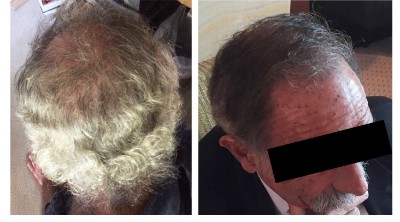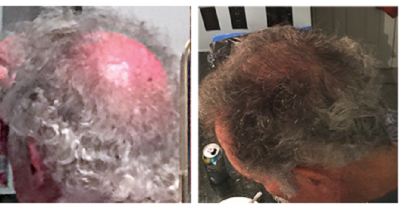During the past several years, the single biggest breakthrough in hair loss treatments has been in the form of Janus Kinase (JAK) inhibitors. They can cure immune system disorders alopecia areata (AA), alopecia totalis and alopecia universalis in many patients. However, before JAK inhibitors came, there was another immune system suppressing drug called cyclosporine that I will discus in this post.
While JAK inhibitors seem to be close to a cure for a majority of patients suffering from alopecia areate, their effect on patients with androgenetic alopecia (AGA) is unproven and controversial. A US based company named Aclaris Therapeutics claims that there is a chance that specialized covalently bound topical JAK inhibitors will cure androgenetic alopecia in many patients (oral JAK inhibitors do not work for AGA but do work for AA). The implication is that male pattern hair loss might have a significant autoimmune component to it, a conclusion that it seems is not supported by many hair loss researchers. It is also possible that topical JAK inhibitors help hair growth via a totally different mechanism unrelated to the immune system.
Cyclosporine A and Hair Growth
Some time ago, I mentioned a study that showed oral cyclosporine A (also referred to as ciclosporin A or as CyA) to benefit scalp hair growth in some men with androgenetic alopecia. I thought it significant that well before JAK inhibitors came on to the scene, there was already a drug in the form of cyclosporine that targeted the immune system and that seemed to benefit scalp hair growth.
However, several bloggers mentioned that topical cyclosporine experiments by some hair loss sufferers did not seem to lead to any decent results insofar as scalp hair regrowth goes. Moreover, the effect of JAK inhibitors versus that of cyclosporine is very different. Also, the past studies linking cyclosporine and hair growth are somewhat ambiguous (more on that further below). I therefore decided to relegate cyclosporine to the backburner for a future post and forgot about it until the below happened.
RiverTown Therapeutics and their Cyclosporine Product
The biggest news in the hair loss world this month has been RiverTown Therapeutics’ new website. Edit: no longer working after the company closed in 2020. I have generally not been too keen about this company even though I have mentioned them several times in my blog posts this year.
My two biggest reasons for being pessimistic about RiverTown are the facts that:
- Minoxidil by itself can give good results in terms of hair growth in some people (so their Minoxidil containing RT1640 product could just be glorified Minoxidil). And a company named Follica (US) has already tried a wounding plus Minoxidil approach that is likely superior to just Minoxidil.
- RiverTown has not even conducted phase 1 clinical trials for RT1640 at present per their product pipeline page. By the time all 3 clinical trials are concluded, we could very well have a few more superior treatments on the market (Follica, Tsuji, Shiseido and more).
Adding to my skepticism about RiverTown are small details such as its actual home page still saying “under construction” as of today. And the CEO’s Linkedin profile does not even having RiverTown listed in there yet.
Having said that, I was pleased to learn that the respected hair loss researchers Dr. Elaine Fuchs and Dr. Maria Hordinsky are both on RiverTown’s scientific advisory board. Moreover, RiverTown’s CEO David Weinstein was previously associated with a company named GliaMed. They had a product called GM1485 that never came to market, but that supposedly (in animals) promoted “the regeneration of all components of the skin after injury, including nerves, hair follicles, blood vessels, dermis and epidermis with minimal scarring”.
Hopefully the fact that last week the US House of Representative overwhelmingly supported the passage of the 21st Century Cures Act will help RiverTown and other companies in the hair loss world bring forth their products to market significantly faster.
In any event, getting back to the subject matter of this post, the reason I mention RiverTown is because the new website clarifies that the company’s RT1640 hair loss product contains three ingredients, one of which is cyclosporine A:
- Minoxidil (already FDA approved).
- Cyclosporine A (already FDA approved).
- RT175 (a proprietary chemical entity developed by one of Rivertown’s co-founders that has been tested in 600 humans).
Cyclosporine A and Hair Loss: Past Studies
So now I had to look up all the past studies that mention Cyclosporine and hair in the same page. Below is a chronological list of the most important such studies, with my notes in blue.
- Cyclosporine and Male-Pattern Alopecia, 1987 (US). Just 1 patient, but a very positive result with new hair growth in the temporal region of the scalp when on cyclosporine, which then went away when off the drug. An interesting quote: “Hypertrichosis has been reported to occur in 60% of kidney transplant recipients treated with cyclosporine”. Hypertrichosis means excessive body hair. If something can grow new body hair (or convert vellus body hair to terminal body hair), it is surely not out of the realm that it can also grow new scalp hair? It should be noted, however, that cyclosporin might be increasing DHT levels and that could be increasing body hair.
- Topical Cyclosporine in Male Pattern Alopecia, 1990 (Israel — from the prestigious Technion University). Two out of 8 human subjects who suffered from AGA saw significant growth when on topical cyclosporine for 4 months. One of those two saw cosmetically evident growth. Same authors have another study from 1988 based on transplanted human hair onto mice, and they concluded that cyclosporine A may be effective in the treatment of alopecia.
- Effects of Cyclosporin A on Hair, 1994 (Germany). A very interesting statement: “One of the most common dermatological side effects of oral CyA is dose-dependent hypertrichosis”. It seems like CyA causes new body hair to develop from vellus hair. Also, the conclusion is that oral application of CyA proved successful in treating AA as well as AGA. However, the topical application failed to treat either condition.
Comparison to JAK inhibitors
While cyclosporine A and JAK inhibitors both have immunosupressive properties, their mechanism of action is different.
According to the earlier mentioned Japanese study, cyclosporine A inhibits T-cell activation by “interfering with the production of interleukin-2 (IL-2) by inhibiting IL-2 gene expression, probably through the inhibition of calcineurin, a Ca2+/calmodulin-dependent phosphatase”. A bit difficult but not impossible to understand. Cyclosporine is used for a number of inflammatory skin conditions, especially psoriasis.
JAK inhibitors are a type of medication that inhibit the activity of one or more of the Janus kinase family of enzymes (JAK1, JAK2, JAK3, TYK2). In the process, they interfere with the critical JAK-STAT signaling pathway. Aclaris is working on a topical covalently binding, highly selective JAK3 inhibitor to cure AGA.
I hope the five or so scientifically astute regular commentators that we have on this blog further compare and discuss JAK inhibitors versus CsA.
My Hypothesis
Over the years, I have read numerous online forum posts from people stating that when they started losing their hair, they also started getting a lot of scalp itching (largely in the same areas where they were also experiencing hair loss). I have witnessed the exact same phenomenon on my own scalp and use dermatologist recommended dandruff shampoos to tackle the problem whenever it arises.
This has led me to wonder whether people who have male pattern hair loss combined with a lot of associated itching, inflammation and dandruff also have an autoimmune component to their hair loss? Perhaps men with male pattern hair loss can be divided into two broad categories:
- Those with an autoimmune component to their hair loss manifesting with itchy scalps and high skin turnover (flaking).
- Those without any autoimmune component (and normal scalps with no itching)?
The fact that both the immunosuppressant drugs CsA and JAK inhibitors can help some men with male pattern hair loss makes this hypothesis less far fetched than originally thought.

